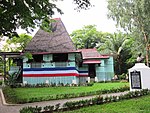University Center for Culture and the Arts
Cultural centersInfoboxes without native name language parameterPolytechnic University of the Philippines
The University Center for Culture and the Arts (UCCA) is a non-profit cultural center of the Polytechnic University of the Philippines. The agency is under the Office of the Vice President for Student Services. The UCCA is currently residing at the PUP Theater inside the PUP College of Communication compound. The UCCA hosts various events inside and outside the university. On August 29, 2014, the Polytechnic University of the Philippines through UCCA conferred the 'Pambansang Artista Ng Mamamayan' award to Nora Aunor in the PUP Theater. The UCCA also spearheads the annual university Arts Month every February.
Excerpt from the Wikipedia article University Center for Culture and the Arts (License: CC BY-SA 3.0, Authors).University Center for Culture and the Arts
Anonas Street, Manila Santa Mesa (Sixth District)
Geographical coordinates (GPS) Address Website Nearby Places Show on map
Geographical coordinates (GPS)
| Latitude | Longitude |
|---|---|
| N 14.5978 ° | E 121.0097 ° |
Address
Polytechnic University of the Philippines (PUP Mabini Campus)
Anonas Street
1016 Manila, Santa Mesa (Sixth District)
Philippines
Open on Google Maps








